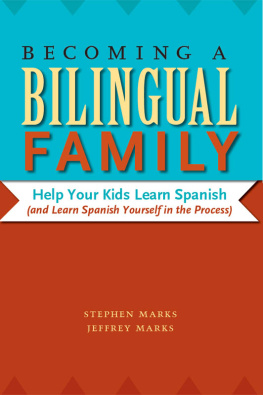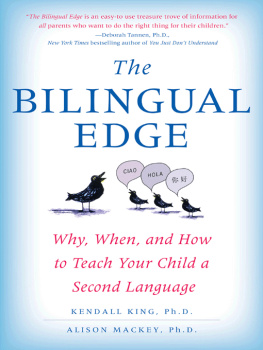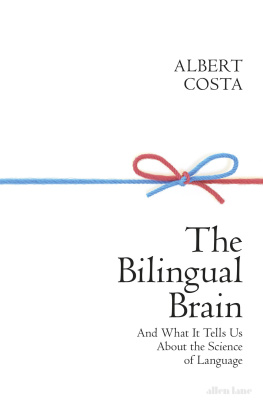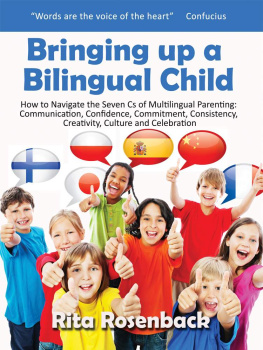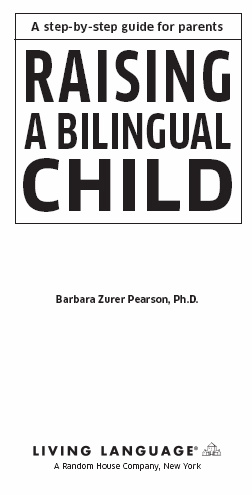
CONTENTS
Tables
Figures
I dedicate this book to my parents, Raymond and Selmajean Zurer; my husband, Wilbur; our children, Sam and Steve and Zach and Miri; and our grandchildren, Daphne, Eli, Ella, Ezra, Hazel, and Seth.
Acknowledgments
Amherst, MA, July, 2007
I want to express my appreciation to my colleagues in the University of Miami Bilingualism Study Group: the original kernelKim Oller, Vivian Umbel, and Maria Fernandezand then those who joined and improved our effortsAlan Cobo-Lewis, Virginia Gathercole, Rebecca Burns-Hoffman, Rebecca Eilers, Batya Elbaum, Erika Hoff, and students Sylvia Fernandez, Ana Navarro, Rosana Resende, Vanessa Lewedag, Arlene McGee, Mike Lynch, and so many others. My current research colleagues at the University of Massachusetts, especially the DELV team members Harry Seymour, Tom Roeper, and Jill and Peter de Villiers, are also a source of inspiration for me. I should acknowledge the National Institutes of Health, which supported much of our work. I am also grateful to the members of the congenial international research community here in Amherst and bilingualism colleagues around the world, among whom I have been honored to work. You will see many of their names in the text and notes.
For their help in whipping the chapters into shape, I thank my earliest readers, who waded through the roughest of drafts: my sister Carol Kline (my strictest taskmaster), daughter Sam Pearson, neighbor Pat Schneider, and coworker Loren Walker. Later, friends Zahava Koren and Beth Berry, sister-in-law Diana Zurer, and brother-in-law Dennis Pearson also contributed their eyes and insight to help shape the text. Thanks also go to neighbor Marielle Lerner, who was home just long enough this year to step in as fact-checker, and my editor, Zvjezdana Vrzic, who kept the question Why do parents need to know that? foremost in my mind at every chapter. Finally, I thank my husband, Wilbur, who gave me the encouragement and the space to devote so much time to this projectall of my days and nights, as the deadlines drew near.
The project itself took less than a year, but I feel I have been preparing for this book my whole career. Its much more demanding to write for parents than for other scholars. I thank Random House for making it possible for me to attempt it.
Introduction
If you are bilingual and you are thinking about or are currently raising your children to be bilingual, this book is for you.
If you are not bilingual, but wonder if you might be able to raise your children to be bilingual, this book is also for you.
Or if you are just interested in the amazing story of how children learn two or more languages at the same time, this book is for you, too.
Raising a Bilingual Child is a guidebook for what to do and what to expect when youre parenting a bilingual-to-be. It also contains general background information that will take you beyond the how, to the why . Sometimes you will use the book as a quick reference to help with a specific strategy. At other times, you may find that you are fascinated, as I am, with the miraculous achievements of small children on their path to language and literacy, and you will want to hear a fuller account of what is happening at different stages. The book gives you this bigger picture as well.
In Raising a Bilingual Child, I want to share with you my passion for languages and my hopes for universal bilingualism. Universal might be too strong, but why not? We all grow up speaking a language. Why dont we all grow up speaking two (or more)? When I speak to people from Guatemala, Denmark, Israel, or India, for example, they say that children are expected to grow up bilingual. It is not at all unusual. In the U.S., the families of diplomats, international businesspeople, and movie stars do it. Their lifestyles may not be typical, but their children are typical children. They are born with the same language-learning equipment as your children and mine.
Personal Fascination and Professional Interest
My own interest in bilingual development is both personal and professional. I was not raised bilingually myself. I first became bilingual as a university exchange student. Maybe it was just the magic of being twenty years old in Paris, but I felt transformed when I discovered a larger world through living in another language. Because I could speak to the French in their language, I heard stories from people whose unique lives I would never have been able to imagine at home in New York. Somehow I found myself more outgoing when I was speaking French and even surprised myself by writing poetry in that languagewhich is not something I typically did in English. Although I was technically beyond the age for learning a second language like a native speaker, I was often mistaken for one. It felt like winning a medal in the language Olympicsbronze if I was taken for someone from a province in France, and silver if the listener thought I was Swiss. (Gold would have been passing for a Parisian. I never won that one.)
Nor were my children raised bilingually from birth. (After all, I didnt have this book!) Fortunately, we lived in the language-rich city of Miami, Florida, and they showed great interest in language as young children and teens. Now, as adults, they, too, are bilingualbut not near-native, as they might have been had they learned their second languages earlier.
Although speaking two languages has been an important part of my adult life, I missed out on the early childhood experience of living in two languages. Happily, my career as a university researcher gave me the gift of sharing closely in the experiences of twenty-five families committed to raising their children bilingually. These families generously permitted my colleagues at the University of Miami and me to record as many aspects of their babies language growth as we could without becoming downright intrusive. We met the babies when they were around three months of age, before they were babbling, and we watched them grow up learning to speak two languages right before our eyes. Through their frequent visits to our lab, we became friends with many of the families, and several parents continued bringing their children back to see us long after the funding for the study had ended and many of the results had been published. Our project was one of the first studies of a large group of young bilinguals, rather than a case study of a single child. In many ways, it was like twenty-five case studies. How different the twenty-five experiences were from each other was as fascinating as the general developmental patterns that we have reported in the scholarly literature.
This infant study was another kind of first as well. It was my first bilingualism research endeavor. Eventually, the University of Miami Bilingualism Study Group (BSG), which I coordinated with D. K. Oller, was funded to work with bilingual groups at many ages, from those first bilingual babies to bilingual toddlers, bilingual schoolchildren, bilingual university students, and a few bilingual adults. The BSG was a wonderfully collegial group, and from those studies, we jointly wrote an academic book and a significant number of presentations and articles for peer-reviewed publications. This experience has enabled me to sift through the growing and sometimes contradictory information on bilingualism now available and to present to you what I think is most helpful to parents.
Who Is This Book For?
Raising a Bilingual Child is for parents or future parents and their friends and relatives. If you are a parent, this book will give you the information you need about choosing two languages for your childrenhow and whyand will reassure you that science is on your side if you do. If you are a relative or friend, you will learn to understand the needs of bilingual families. I will also be happy if this book finds its way into the hands of people who have not given bilingualism any thought. This book will teach you how you, as a caregiver, can recognize or create an environment where children will flourish in two languages. It offers both a broad overview of the phenomenon of bilingualism and detailed steps you can take to provide your children the motivation and the opportunity for meaningful interactions in two languages within the normal routines of your life.
Next page



